The Crown’s Jewels, the First Quarter Moon Meanders through Bright Planets, Jupiter bears Black and Red Spots, and Neptune Kisses a Star!
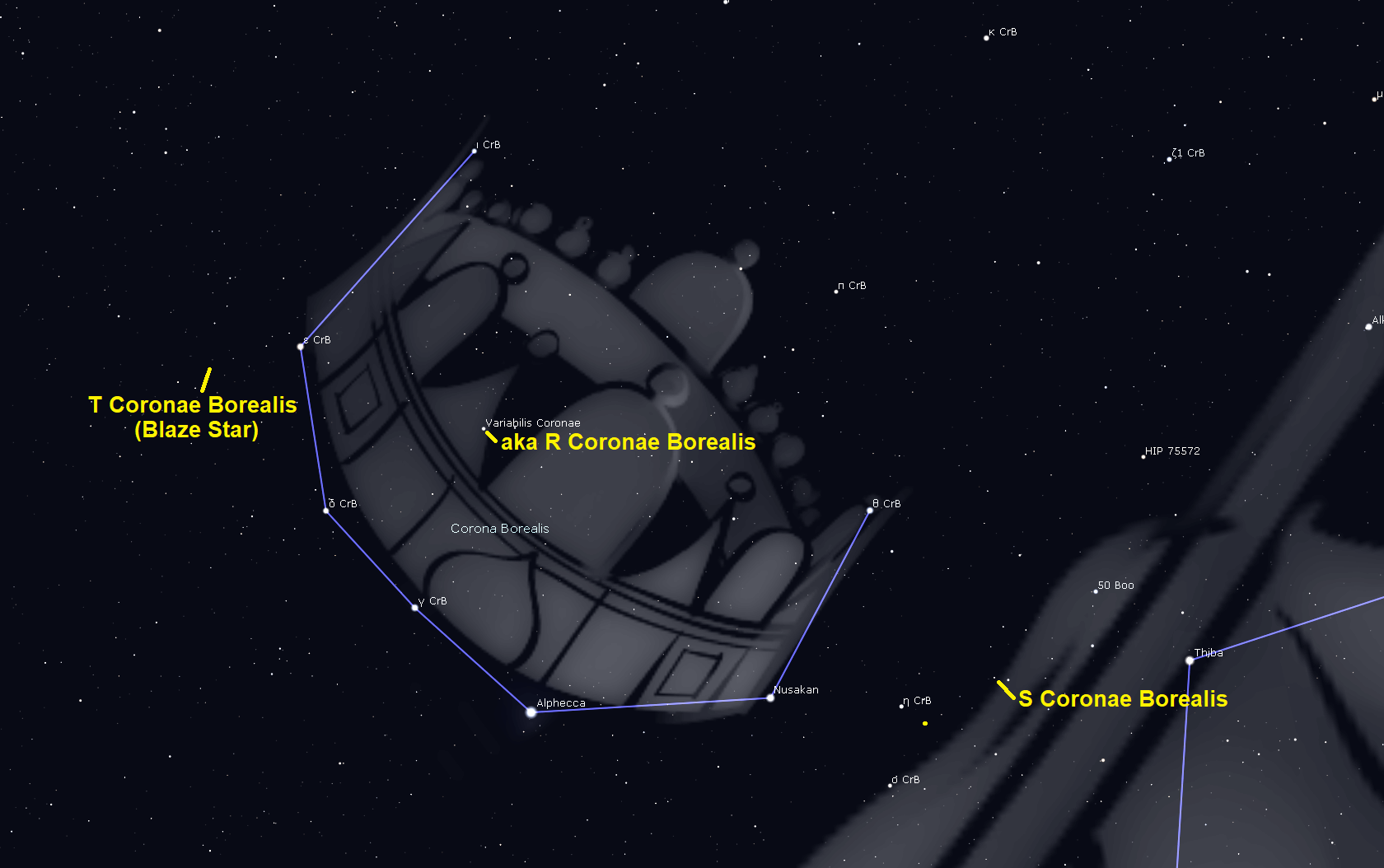
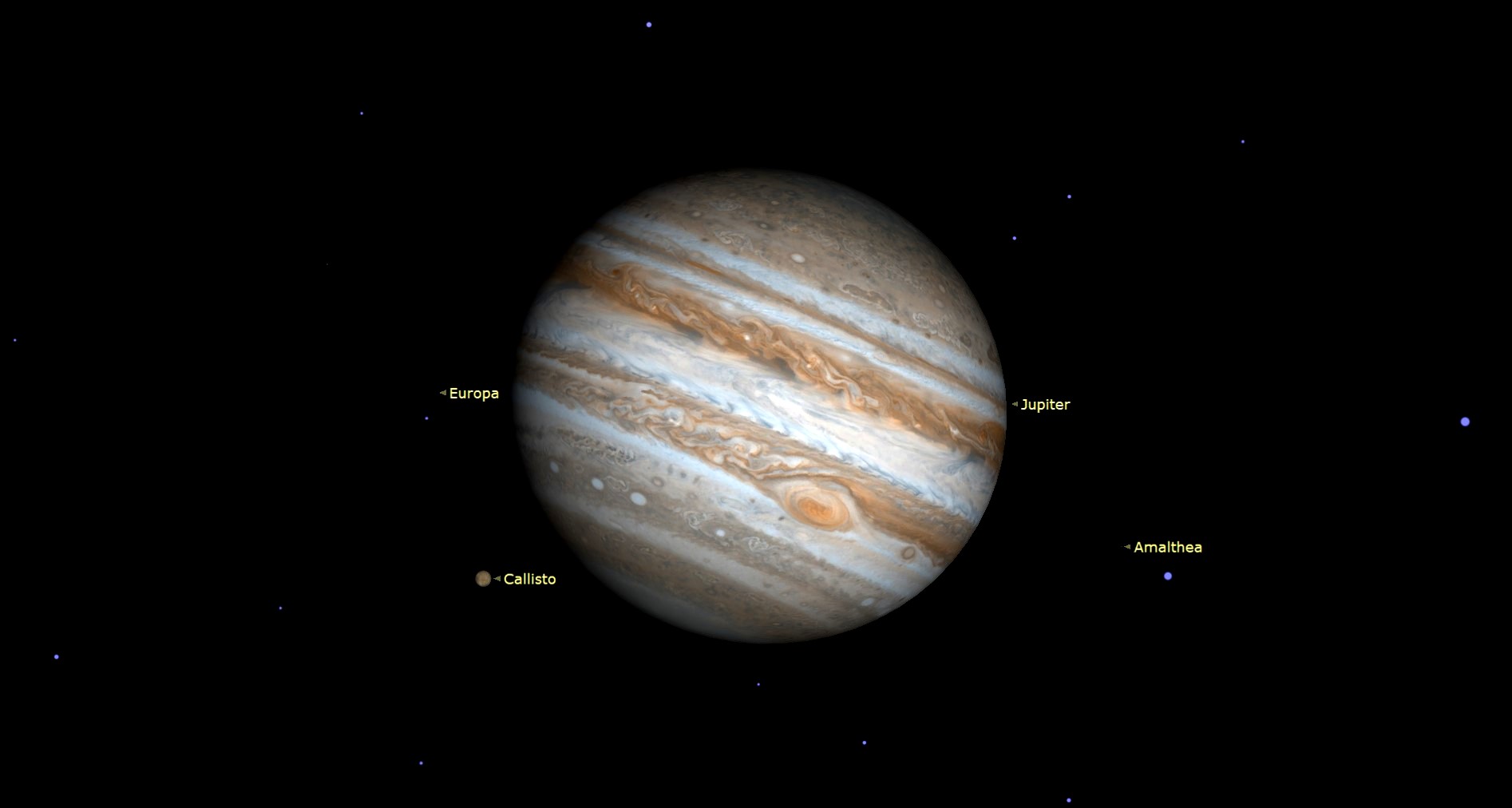
Hello, Late Summer Stargazers!
Here are your Astronomy Skylights for the week of September 1st, 2019 by Chris Vaughan. Feel free to pass this along to your friends and send me your comments, questions, and suggested topics. I repost these emails with photos at http://astrogeoguy.tumblr.com/ where all the old editions are archived. You can also follow me on Twitter as @astrogeoguy! Unless otherwise noted, all times are Eastern Time. Please click this MailChimp link to subscribe to these emails.
I can bring my Digital Starlab inflatable planetarium to your school or other daytime or evening event. Contact me, and we’ll tour the Universe together!
The Moon and Planets
If last week was the best week for skywatchers worldwide, this is the week for lunatics – the lovers of our natural satellite, Luna! Between now and next Sunday, the moon will March across the evening sky worldwide, waxing in phase and visiting two bright planets. Meanwhile, we have a minor meteor shower underway, and we can enjoy summer constellation sights in evening, autumn ones at midnight, and our winter treats during the pre-dawn hours. Here are your Skylights!
The moon will begin the week as a delicate waxing crescent visible over the western horizon after sunset. Watch for Earthshine – sunlight that has reflected off the seas and white clouds of Earth and is illuminating the unlit portion of the moon’s near side. The bright, white star that you see below the moon (or above it, if you live south of the Equator) on Sunday and Monday evening is Spica, the brightest star in Virgo (the Maiden). Note how the moon moves with respect to that star from one night to the next.
On Wednesday and Thursday, the now healthy crescent moon will pass through the modest stars of Libra (the Scales). The moon never wanders far from the Ecliptic, the imaginary line that traces the sun’s path through the zodiac constellations. So the moon is usually within those familiar constellations, allowing you to see where they are – even after the moon has moved away from them.
Thursday will bring the First Quarter Moon phase – when the angle formed by the sun, Earth, and moon forms a right-angle, causing the moon to appear half-illuminated, on its eastern side. (East and west on the moon are opposite to sky directions on Earth.) First quarter moons always rise around noon time, allowing you to see them in the afternoon. Evenings around first quarter are the best ones for viewing the moon in binoculars and backyard telescopes. The topography along the terminator – the pole-to-pole line that divides the lit and dark halves – is being lit by low-angled sunlight which produces breathtaking vistas of bright mountain peaks and crater rims, and the deep black shadows they cast. Moon phases are shared by everyone around the world.

Thursday night will also begin the moon’s dance with the gas giant planets. Look for the moon in the southwestern sky, and positioned less than four finger widths to the right (or 4 degrees to the celestial northwest) of the bright planet Jupiter. The moon and Jupiter will both fit within the field of view of binoculars. If you watch the pair over several hours, starting at dusk, you will see the moon’s orbit carry it closer to the planet. Look for the bright reddish star Antares “the Rival of Mars” twinkling below the moon. That is the heart of Scorpius (the Scorpion). To the west of Antares, three little white stars in a vertical line and each separated by three finger widths from the next one, represent the critter’s claws. Remember that Jupiter will stay with the scorpion after the moon moves away – all through autumn, in fact.
On Friday night, the waxing gibbous (i.e., more than half-full) moon will hop to sit on the east side of Jupiter. Then, on Saturday night, the moon will land immediately above the Teapot-shaped stars of Sagittarius (the Archer), and a palm’s width the right (or celestial west) of Saturn. As with Jupiter, the moon will hop to the other side of Saturn on Sunday night. The ringed planet will stay near the Teapot for the rest of this year.
Mercury, Venus, and Mars are out of sight – hidden in the sun’s glare, for now. But the two fast inner planets will bring them into view in the evening sky next week. Mars reaches conjunction with the sun on Monday morning. For a period of time, we will have trouble communicating with our robotic avatars on the surface and orbiting around that planet.
As the sky begins to darken this week, look for the giant planet Jupiter sitting less than a third of the way up the southwestern sky. Hour by hour, Jupiter will sink lower – then set in the west before midnight local time. Jupiter is spending the rest of this year between Ophiuchus (the Serpent-Bearer) and Scorpius (the Scorpion). Normally a planet becomes harder to see when it reaches the southwestern evening sky. But the earlier sunsets and the planet’s brilliance will keep it in view for some time to come.
On a typical night, even a backyard telescope will show you Jupiter’s two main equatorial stripes and its four Galilean moons – Io, Europa, Callisto, and Ganymede looking like small white dots arranged in a rough line flanking the planet. If you see fewer than four dots, then some of them are in front of Jupiter, or hidden behind it. Good binoculars will show the moons, too!
From time to time, the small, round, black shadows cast onto Jupiter’s surface by those four Galilean moons become visible in amateur telescopes as they cross (or transit) Jupiter’s disk. On Wednesday, September 4 from 9:21 to 11:33 pm EDT, observers in the Americas can watch Io’s shadow transit Jupiter, accompanied by the Great Red Spot!
Due to Jupiter’s rapid 10-hour rotation period, the Great Red Spot (or GRS) is only observable from Earth every 2nd or 3rd night, and only during a predictable three-hour window. The GRS will be easiest to see using a medium-sized, or larger, aperture telescope on an evening of good seeing (steady air). If you’d like to see the Great Red Spot in your telescope, it will be crossing the planet on Monday evening from dusk to 11 pm EDT, on Wednesday from 9:20 to 11:30 pm EDT (accompanied by the Great Red Spot), and on Saturday from dusk until 10 pm EDT.
Yellow-tinted Saturn is prominent in the southern evening sky, too – but it is less bright than Jupiter. The ringed planet will be visible from dusk until about 2 am local time. Saturn’s position in the sky is just to the upper left (or celestial east) of the stars that form the teapot-shaped constellation of Sagittarius (the Archer). To find Saturn, look about 3 fist diameters to the left (east) of Jupiter. The Milky Way is between them.
Dust off your telescope! Once the sky is dark, even a small telescope will show Saturn’s rings and several of its brighter moons, especially Titan! Because Saturn’s axis of rotation is tipped about 27° from vertical (a bit more than Earth’s axis), we can see the top surface of its rings, and its moons can arrange themselves above, below, or to either side of the planet. During this week, Titan will migrate counter-clockwise around Saturn, moving from the upper left of Saturn tonight (Sunday) to below the planet next Sunday. (Remember that your telescope will flip the view around.)
Tiny, blue Neptune will rise at dusk this week, and then it will climb the eastern sky until it reaches its highest point, due south, at about 1:30 am local time. The planet is among the stars of Aquarius (the Water-Bearer). Recently, Neptune has been sitting just to the left (celestial east) of a medium-bright star named Phi (φ) Aquarii. Neptune is actually moving slowly toward that star and will “kiss” it on Thursday and Friday nights this week, helping you to find the dim planet!
Astronomers call such an event a conjunction. Being so close together, both the star and Neptune will appear together in the field of view of a small telescope. But blue Neptune’s light has been travelling for 4 hours to reach your eye, while the warmly-tinted light of Phi Aquarii has been journeying for 202 years! After this weekend, the distance between the two objects will increase due to Neptune’s eastward orbital motion.
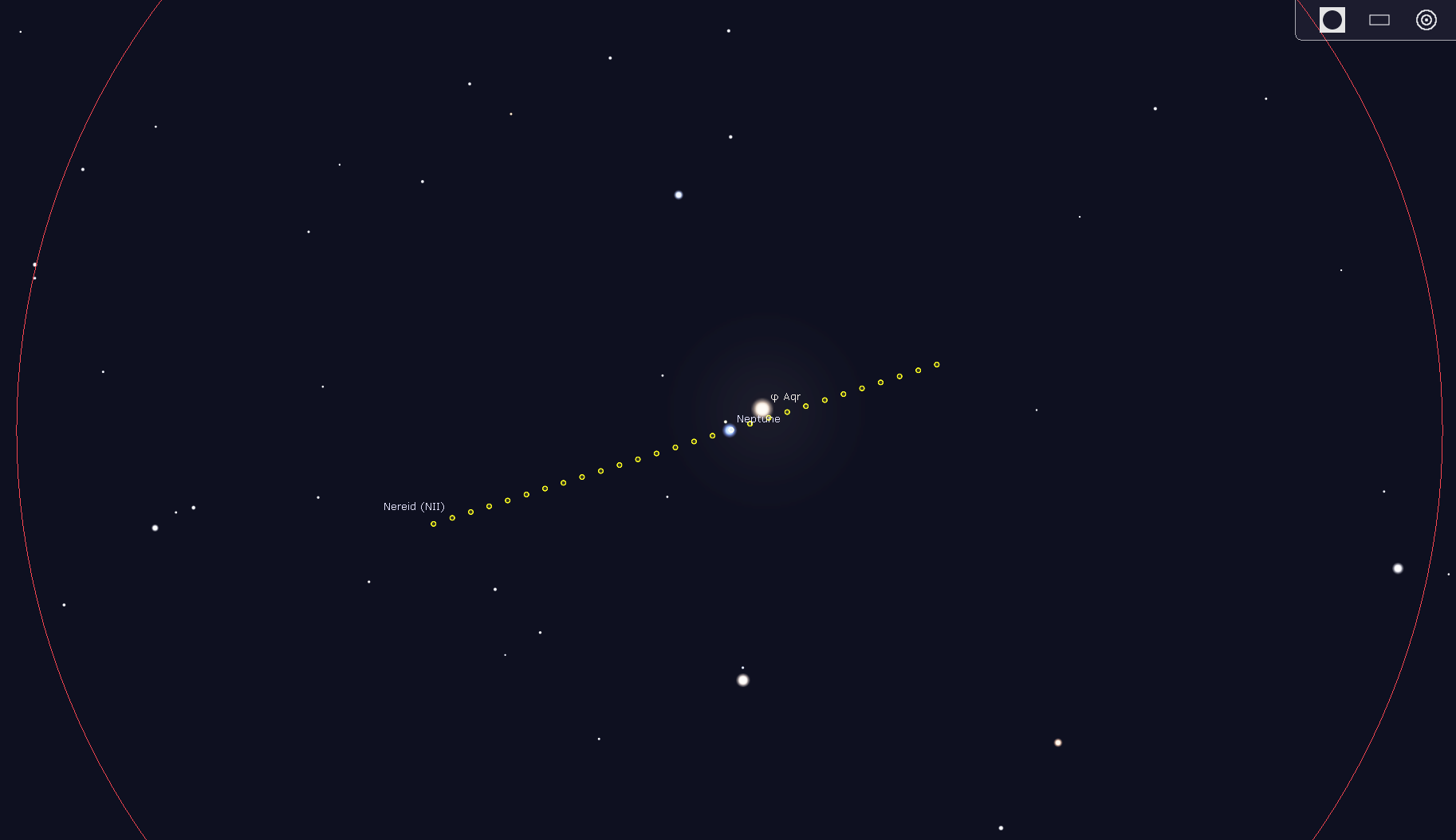
Blue-green Uranus will be rising in the east just before 10 pm local time this week; and it will remain visible all night long. Uranus is sitting below (celestial south of) the stars of Aries (the Ram) and is just a palm’s width above the head of Cetus (the Whale). At magnitude 5.8, Uranus is actually bright enough to see in binoculars and small telescopes, under dark skies – and it really does look blue! You can use the three modest stars that form the top of the head of the whale (or sea-monster in some tales) to locate Uranus for months to come – that’s because that distant planet moves so slowly in its orbit. To help you find it, here’s a detailed star chart.
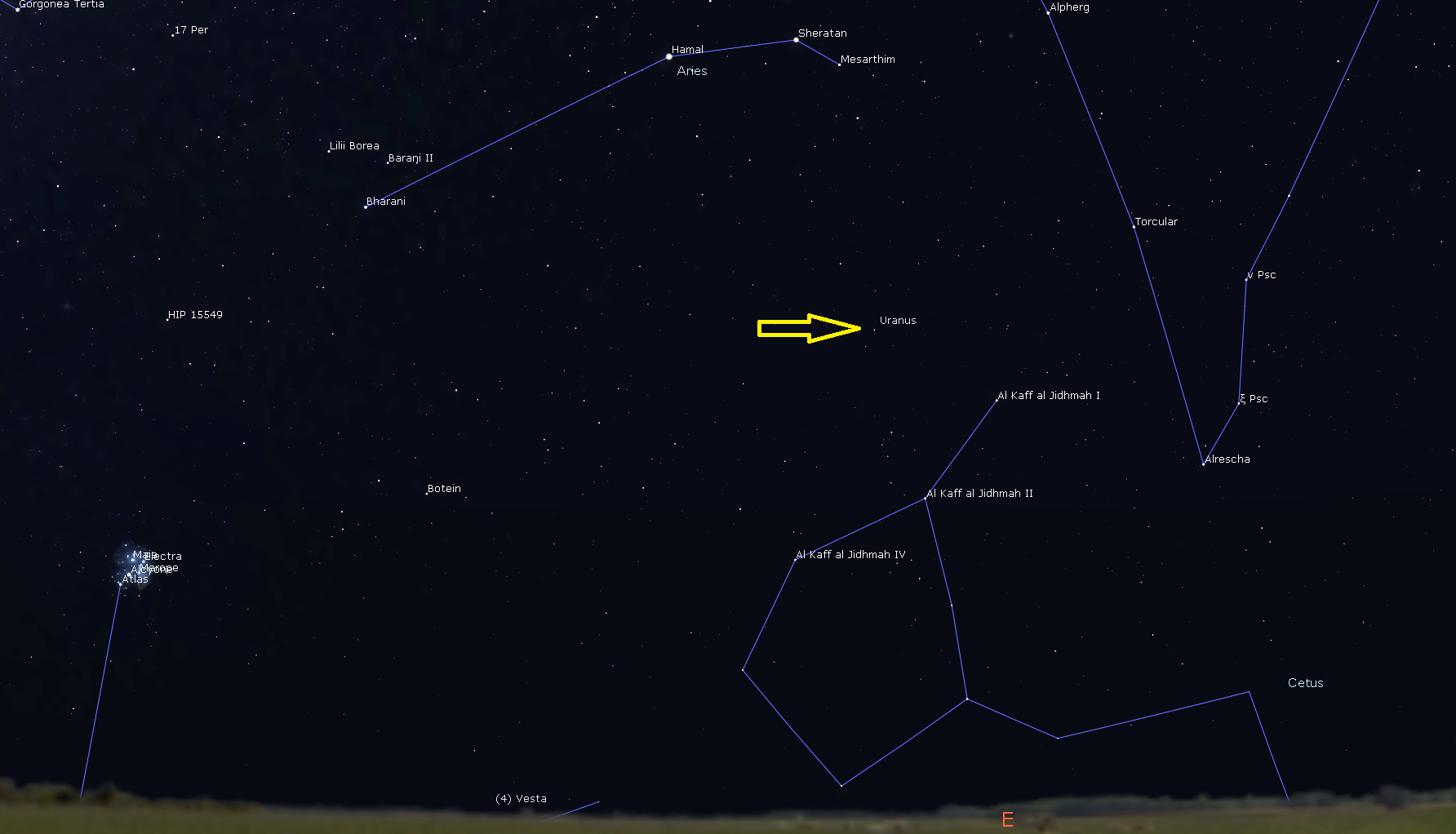
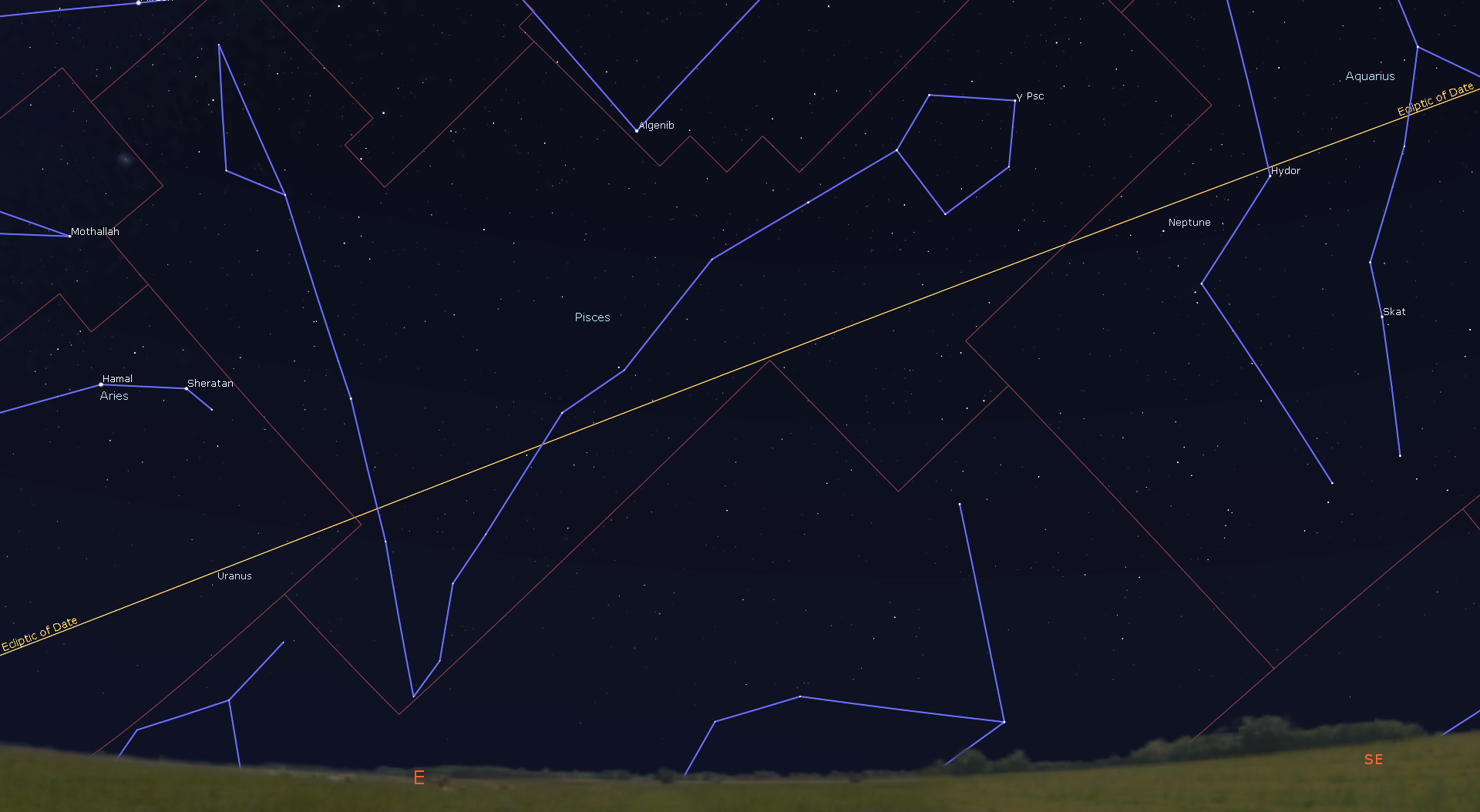
Aurigids Meteor Shower
A minor meteor shower named the Aurigids is underway. It peaks today (Sunday) and ends next weekend. Look for several of these meteors per hour. They’ll be moving away from the northeastern horizon, where the constellation that gives them their name, Auriga (the Charioteer), rises in late evening.
The Northern Crown is in the West
Corona Borealis (the Northern Crown) can be spotted halfway up the western evening sky in early September. The constellation actually sits about midway along the imaginary line that joins the two bright stars Vega and Arcturus. The earlier autumn sunsets extend our opportunity to explore Corona Borealis. This incomplete circlet of medium-bright stars is roughly 7 degrees across (a generous palm’s width). It is both a constellation and an asterism (an informal star pattern). Corona Borealis’ brightest star Alphecca is a white, A-class star located 75 light-years from the sun. Alphecca’s placement in the constellation is reminiscent of a diamond in a ring. The star’s name derives from the Arabic expression for “broken”, referring to the incomplete ring.
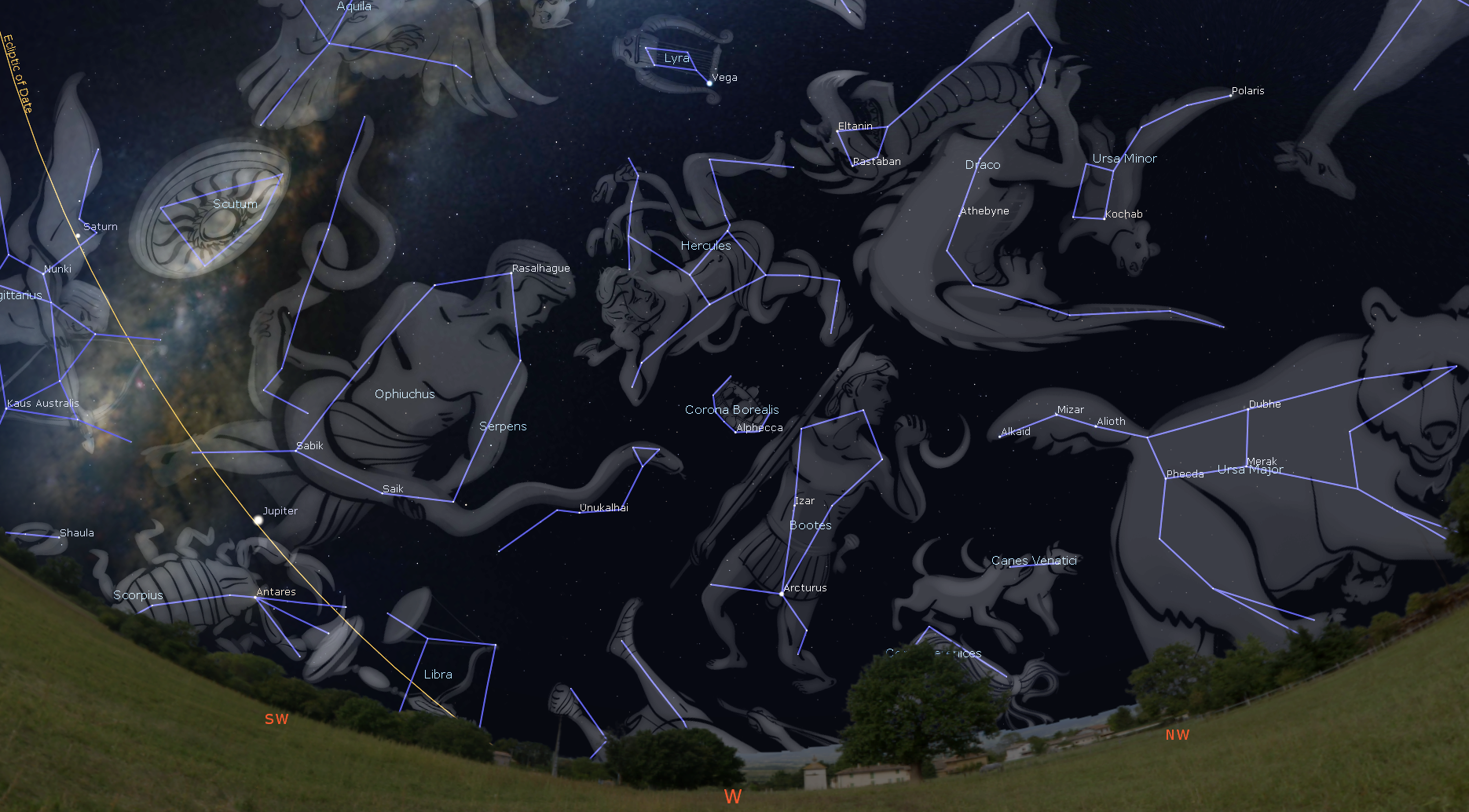
While the Northern Crown is poor in deep sky objects, it contains several interesting jewels – double stars and variable stars. Alphecca itself is an eclipsing binary system that varies in brightness by a tiny amount every 17.36 days, similar to the behavior of the star Algol in Perseus (the Hero). Eruptive variable stars are named for the star R Coronae Borealis, which is located about three finger widths above (or 3.5 degrees to the celestial northeast of) Alphecca. R Corona Borealis is a hydrogen-deficient and carbon-rich supergiant star. From time to time, it’s usual visual magnitude of 5.8 drops to as little as magnitude 14, possibly due to the formation of opaque carbon dust that blocks visible light, but passes infrared wavelengths.
Another star named S Coronae Borealis exhibits the same range of variability, but with a 360-day period. The Blaze Star (or T Coronae Borealis) is a cataclysmic variable star, also called a recurrent nova-type. Normally shining between visual magnitude 10.2 and 9.9, on rare occasions it has brightened to magnitude 2 in a period of hours, caused by a nuclear chain reaction and the subsequent explosion. During those times, this normally hidden star becomes bright enough to see in light-polluted skies!

August-September Stargazing Suggestions – Lyra
If you missed last week’s tour of the constellation of Lyra (the Harp), I posted it here. Over the next weeks, we’ll look at some other constellations, too.
Public Astro-Themed Events
Taking advantage of the moon and other bright objects in the sky this week, the RASC Toronto Centre astronomers will hold their free monthly public City Sky Star Party in Bayview Village Park (steps from the Bayview subway station), starting around 8 pm on the first clear weeknight this week (Tues to Thu only). You don’t need to be an RASC member, or own any equipment, to join them – looks are free! Check here for details, and check the banner on their website home page or Facebook page for the GO or NO-GO decision around 5 pm each day.
Every Monday evening, York University’s Allan I. Carswell Observatory runs an online star party – broadcasting views from four telescopes/cameras, answering viewer questions, and taking requests! Details are here. On Wednesday nights they offer free public viewing through their rooftop telescopes. If it’s cloudy, the astronomers give tours and presentations. Details are here.
If the skies are clear on Thursday evening, September 5, local astronomers will set up their telescopes in Old Thornhill Village. This free event starts at 8 pm and everyone is welcome to come out for a look at the Moon, Jupiter and Saturn, and a variety of deep-sky treasures. The viewing location is Thornhill’s very own “dark-sky oasis,” the Pomona Meadow – situated north of the cemetery on Charles Lane, and east of the Ukrainian Catholic Church of St. Volodymyr. Park for free at the church and just follow the paved path. The rain or cloud date is Thursday, October 3 at 7:00 pm. Dress warmly, and we’ll see you there!
Eastern GTA sky watchers are invited to join the RASC Toronto Centre and Durham Skies for solar observing and stargazing at the edge of Lake Ontario in Millennium Square in Pickering on Friday evening, September 6, from 6 pm to 11 pm. Details are here. Before heading out, check the RASCTC home page for a Go/No-Go call in case it’s too cloudy to observe. The rain date is Saturday. That same evening, RASC and Durham Skies will be donating a telescope to the Pickering Public Library in a public ceremony. In case of rain or bad weather, the ceremony will be moved to the Pickering Library Auditorium (2nd floor) at 1 The Esplanade.
If it’s sunny on Saturday morning, September 7 from 10 am to noon, astronomers from the RASC Toronto Centre will be setting up outside the main doors of the Ontario Science Centre for Solar Observing. Come and see the Sun in detail through special equipment designed to view it safely. This is a free event (details here), but parking and admission fees inside the Science Centre will still apply. Check the RASC Toronto Centre website or their Facebook page for the Go or No-Go notification.
Please note: Due to some filming permits at DDO, some of our events in September have been cancelled. Here’s the updated information…
The next RASC-hosted Night at the David Dunlap Observatory will be on Saturday, September 21. There will be sky tours in the Skylab planetarium room, space crafts, a tour of the giant 74” telescope, and viewing through the 74” and lawn telescopes (weather permitting). The doors will open at 8:30 pm for a 9 pm start. Attendance is by tickets only, available here. If you are a RASC Toronto Centre member and wish to help us at DDO in the future, please fill out the volunteer form here. And to join RASC Toronto Centre, visit this page.
This Fall and Winter, spend a Sunday afternoon in the other dome at the David Dunlap Observatory! On Sunday afternoon, October 20, from noon to 4 pm, join me in my Starlab Digital Planetarium for an interactive journey through the Universe at DDO. We’ll tour the night sky and see close-up views of galaxies, nebulas, and star clusters, view our Solar System’s planets and alien exo-planets, land on the moon, Mars – and the Sun, travel home to Earth from the edge of the Universe, hear indigenous starlore, and watch immersive fulldome movies! Ask me your burning questions, and see the answers in a planetarium setting – or sit back and soak it all in. Sessions run continuously between noon and 4 pm. Ticket-holders may arrive any time during the program. The program is suitable for ages 3 and older, and the Starlab planetarium is wheelchair accessible. For tickets, please use this link.
Satellites
There are no visible Iridium Flares predicted for the GTA this week.
The ISS (International Space Station) is visible gliding silently over the GTA this week. The best passes at (mostly) convenient times are listed below. (Note: The more negative the Mag. number, the brighter. The larger the Alt. number, the higher up it is!) Some passes are high and bright! (Data adapted from www.Heavens-above.com. If you enter your location in their website, you will get a list of them for your location.) All the times are in Eastern Time.
Date Start & End Times (EDT) Direction of Travel Max Alt. Mag.
Mon, 2-Sep 4:59:49 am to 5:03:41 am moves WNW to NE 47° -3.2 !!
Tue, 3-Sep 4:12:59 am to 4:14:58 am moves NE to NE 32° -2.0
Tue, 3-Sep 5:45:59 am to 5:51:33 am moves WNW to NE 24° -1.9
Wed, 4-Sep 4:59:00 am to 5:02:46 am moves NW to NE 28° -2.3
Thu, 5-Sep 4:12:07 am to 4:14:02 am moves NNE to NE 26° -1.7
Thu, 5-Sep 5:45:40 am to 5:50:54 am moves NW to NE 21° -1.6
Fri, 6-Sep 4:58:07 am to 5:01:57 am moves NW to NE 22° -1.7
Sat, 7-Sep 4:11:14 am to 4:13:05 am moves NNE to NE 21° -1.3
Sat, 7-Sep 5:45:01 am to 5:50:29 am moves NW to ENE 22° -1.6
Sun, 8-Sep 4:57:15 am to 5:01:21 am moves NNW to NE 21° -1.5
Keep looking up, and enjoy the sky when you do. I love questions and requests – so, send me some!